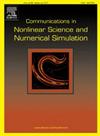Patterns of burned area by a cellular-automata fire simulator: The role of microscale wind field
IF 3.4
2区 数学
Q1 MATHEMATICS, APPLIED
Communications in Nonlinear Science and Numerical Simulation
Pub Date : 2025-06-27
DOI:10.1016/j.cnsns.2025.109026
引用次数: 0
Abstract
Wildfire dynamics simulated using PROPAGATOR, a quasi-empirical cellular automaton model, is studied by investigating the effects of wind-terrain interactions on the predicted burned area patterns. In order to do so, PROPAGATOR is coupled with WindNinja, a microscale wind simulator that computes spatially varying wind fields by a solver accounting for the conservation of mass and a second one assuming also conservation of momentum. Two historical fires are considered: the first one occurred in quasi-flat terrain in the Molise region of Italy, while the second ignited in the southern area of Avinyo in Spain. The standard fire simulator incorporating solely uniform wind fields and that coupled with the solvers of WindNinja predict similar burning probability maps for the Campomarino fire. The quasi-flatness of the Campomarino terrain is the main cause since the wind pattern is very weakly affected by its topography during fire propagation, resulting in only a slight deviation from the initial uniform wind field. However, in the presence of the complex topography of the Avinyo region, the fire spread simulations incorporating the spatially-varying wind fields predict significantly different burned area shapes for long time regimes and intense winds, where secondary fire spots separated from the main burning zone emerge. Larger spatial extension of the wildfire is observed in the absence of firefighters’ actions, but the predicted patterns seem to be similar regardless of the type of wind field input and its resolution. A 10-fold increase of perturbation magnitude on wind direction yields a contraction of the predicted burned area for all the probability thresholds considered, while a 2-fold and 10-fold increase of the wind speed perturbations lead to a significantly larger burned area and fire spread. Further quantitative analysis of the importance of incorporating spatially-varying wind fields in improving the predictability of cellular automata models in the case of megafires is mandatory.元胞自动机火灾模拟器的燃烧区域模式:微尺度风场的作用
利用准经验元胞自动机模型PROPAGATOR模拟野火动态,研究风-地形相互作用对预测燃烧面积模式的影响。为了做到这一点,PROPAGATOR与WindNinja结合在一起,这是一个微型风模拟器,通过计算质量守恒和动量守恒的求解器来计算空间变化的风场。历史上的两次火灾被考虑:第一次发生在意大利莫利塞地区的准平坦地带,而第二次发生在西班牙阿维约南部地区。标准的火灾模拟器结合了单一的均匀风场,并与WindNinja的求解器相结合,预测了Campomarino火灾的类似燃烧概率图。Campomarino地形的准平坦性是火灾传播过程中风型受地形影响非常弱的主要原因,导致与初始均匀风场的偏差很小。然而,在Avinyo地区复杂地形的存在下,结合空间变化风场的火灾蔓延模拟预测了长时间制度和强风下明显不同的烧伤区域形状,在那里出现了与主燃烧区分离的次要火点。在没有消防员行动的情况下,野火的空间扩展更大,但无论风场输入的类型及其分辨率如何,预测模式似乎都是相似的。对于所有考虑的概率阈值,风向扰动幅度增加10倍会导致预测的燃烧面积缩小,而风速扰动增加2倍和10倍会导致燃烧面积和火势蔓延明显扩大。在特大火灾的情况下,进一步定量分析纳入空间变化风场对提高元胞自动机模型的可预测性的重要性是必要的。
本文章由计算机程序翻译,如有差异,请以英文原文为准。
求助全文
约1分钟内获得全文
求助全文
来源期刊

Communications in Nonlinear Science and Numerical Simulation
MATHEMATICS, APPLIED-MATHEMATICS, INTERDISCIPLINARY APPLICATIONS
CiteScore
6.80
自引率
7.70%
发文量
378
审稿时长
78 days
期刊介绍:
The journal publishes original research findings on experimental observation, mathematical modeling, theoretical analysis and numerical simulation, for more accurate description, better prediction or novel application, of nonlinear phenomena in science and engineering. It offers a venue for researchers to make rapid exchange of ideas and techniques in nonlinear science and complexity.
The submission of manuscripts with cross-disciplinary approaches in nonlinear science and complexity is particularly encouraged.
Topics of interest:
Nonlinear differential or delay equations, Lie group analysis and asymptotic methods, Discontinuous systems, Fractals, Fractional calculus and dynamics, Nonlinear effects in quantum mechanics, Nonlinear stochastic processes, Experimental nonlinear science, Time-series and signal analysis, Computational methods and simulations in nonlinear science and engineering, Control of dynamical systems, Synchronization, Lyapunov analysis, High-dimensional chaos and turbulence, Chaos in Hamiltonian systems, Integrable systems and solitons, Collective behavior in many-body systems, Biological physics and networks, Nonlinear mechanical systems, Complex systems and complexity.
No length limitation for contributions is set, but only concisely written manuscripts are published. Brief papers are published on the basis of Rapid Communications. Discussions of previously published papers are welcome.
 求助内容:
求助内容: 应助结果提醒方式:
应助结果提醒方式:


